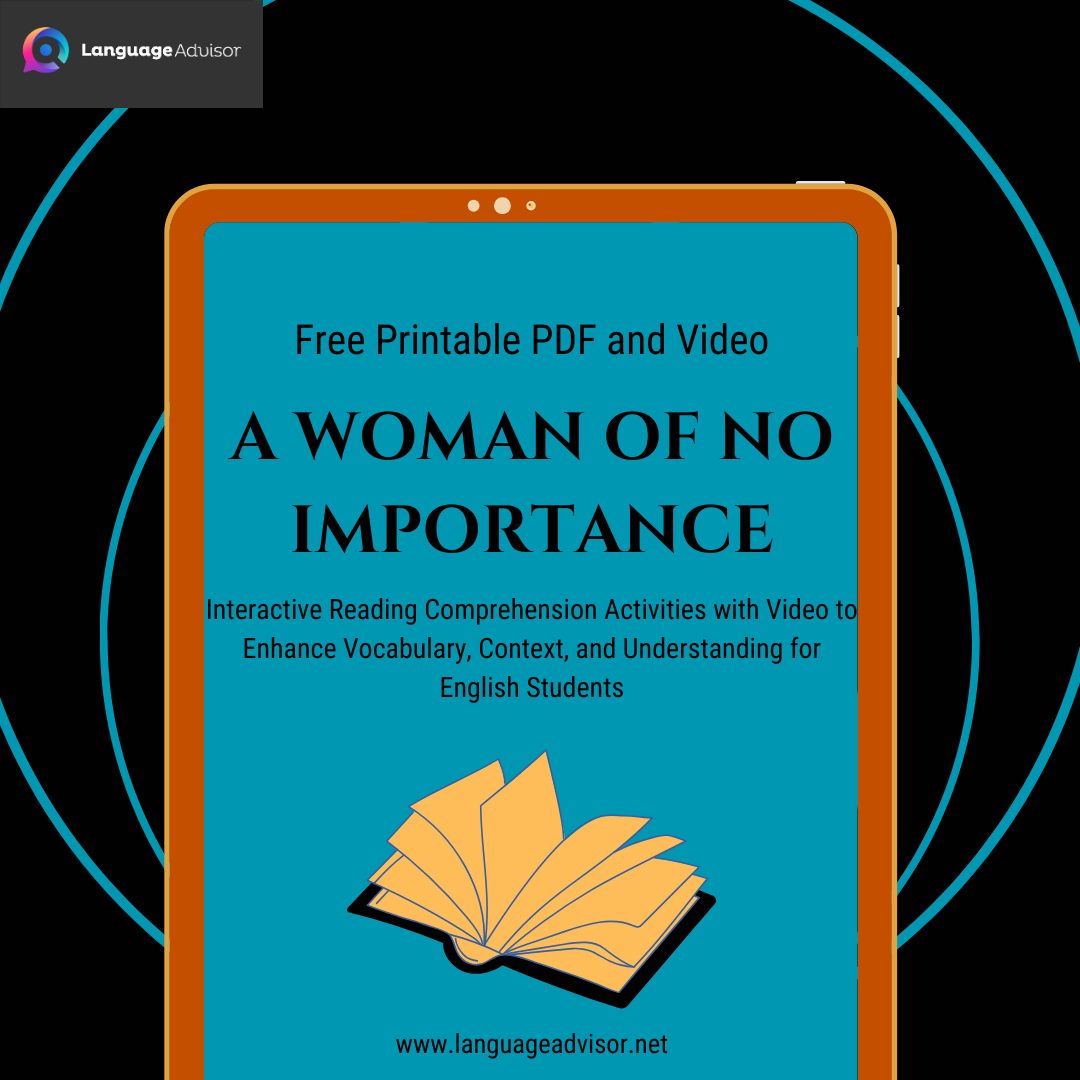A woman of no importance. Interactive Reading Comprehension Activities with Video to Enhance Vocabulary, Context, and Understanding for English Students. Free Printable PDF
A woman of no importance

Improving reading comprehension is a vital skill for English learners at all levels. It goes beyond just understanding the words on the page, but also involves grasping meaning, context, and intent behind a text. One effective way to enhance reading comprehension is by integrating listening alongside written exercises. In this blog post, we’ll explore a fun and interactive reading comprehension activity that combines written passages with listening resources to deepen understanding and make learning more enjoyable.

A woman of no importance – Reading Comprehension
Virginia Hall is one of the most important American spies people have never heard of. Now more than 70 years after her World War II exploits, she’s having a moment. Her long-hidden story is being told in several books and movies. Here’s NPR’s Greg Myre.
GREG MYRE, BYLINE: A great place to learn about Virginia Hall is, unfortunately, off-limits to the public – the CIA Museum inside the spy agency headquarters in Langley, Va.
JANELLE: One of the things that we’re looking at is a case that’s devoted to Virginia Hall. She was the most highly decorated female civilian during World War II.
MYRE: Janelle, the museum’s deputy director, shows us around. Like many who work at the CIA, she’s not allowed to give her last name to the media. So why haven’t we heard more about Hall? Janelle answers with a quote from Hall on her display.
JANELLE: It says, many of my friends were killed for talking too much.
MYRE: Yet finally, for no obvious reason, Hall’s story is resonating outside the walls of the CIA. Three books have just come out. Two movies are in the works. British author Sonia Purnell wrote one of the books, called “A Woman Of No Importance.”
SONIA PURNELL: Through a lot of her life – the early life – she was constantly rejected and belittled.
MYRE: Hall was born to a wealthy Baltimore family in 1906 and was raised to marry into her own privileged circle. But she wanted adventure. She called herself capricious and cantankerous. She liked to hunt. And she once went to school wearing a bracelet made of live snakes. In college, Hall studied in Paris and fell in love with France. She decided to become a diplomat, says Purnell.
PURNELL: She wanted to be an ambassador. She got pushed back by the State Department. She applied several times.
MYRE: The diplomatic ranks were all but closed to women. Hall did land a clerical job at a U.S. consulate in Turkey. But while hunting birds, she accidentally shot herself in the foot. Gangrene set in, and her left leg was amputated below the knee. Recovery was long and painful as she learned to use a clunky, wooden leg. Yet it was also a turning point, says Craig Gralley, a retired CIA officer who’s written his own book on Hall called “Hall Of Mirrors.”
CRAIG GRALLEY: She had been given a second chance at life and wasn’t going to waste it. And her injury, in fact, might have bolstered her or reawakened her resilience so that she was, in fact, able to do great things.
MYRE: When World War II erupted and Nazi Germany invaded France, Hall volunteered to drive an ambulance for the French. But France was soon overrun, forcing her to flee to Britain. A chance meeting with a spy put her in contact with British intelligence. After limited training, this one-legged American woman was among the first British spy sent into Nazi-occupied France. She posed as a reporter for The New York Post. Hall was a natural spy, keeping one step ahead of the German secret police – the Gestapo.
GRALLEY: Virginia Hall, to a certain extent, was invisible. She was able to play on the chauvinism of the Gestapo at the time. And none of the Germans early in the war necessarily thought that a woman was capable of being a spy.
MYRE: Hall operated in the eastern city of Lyon. She stayed at a convent and persuaded nuns to help her. Hall organized French Resistance fighters, giving them safe houses and intelligence. This didn’t go unnoticed, says Sonia Purnell.
PURNELL: The Germans came to realize that they were after a limping lady.
MYRE: Hall constantly changed her appearance.
PURNELL: She could be four different women in the space of an afternoon with four different code names.
MYRE: The man in hot pursuit was the Gestapo’s infamous Klaus Barbie, known as the Butcher of Lyon for the thousands his forces tortured and killed. Barbie ordered wanted posters of Hall that featured a drawing of her above the words, the enemy’s most dangerous spy. The Nazis were on her trail in late 1942. Hall narrowly escaped to Spain, walking three days and 50 miles over the forbidding Pyrenees Mountains. While researching his book, Craig Gralley made part of that walk and found it exhausting.
GRALLEY: I could only imagine the kind of will and perseverance that Virginia Hall had by making this track not on a beautiful day but in the dead of winter and with a prosthetic leg that she had to drag behind her through snow.
MYRE: Hall was safe, but she grew restless and wanted to return to France. The British refused, fearing it was too dangerous. However, the Americans were ramping up their own intelligence service – the Office of Strategic Services. They needed Hall. Yet the Nazis were everywhere, making it even more difficult for her to operate, says Sonia Purnell.
PURNELL: She got some makeup artist to teach her how to draw in wrinkles on her face. She also got a fierce – a rather sort of scary London dentist to grind down her lovely, white, American teeth so that she looked like a French milkmaid.
MYRE: Hall’s second tour in France was even more successful than the first. She called in air drops for the resistance fighters, who blew up bridges and sabotaged trains. They reclaimed villages well before Allied troops advanced that deep into France. Hall’s network consisted of some 1,500 people, including a French-American soldier who later became her husband. Hall’s niece, Lorna Catling, is now 89. She recalls meeting her aunt after the war.
LORNA CATLING: She came home in 1946, when I was 16. She was pale and had white hair and crappy clothes.
MYRE: And what did Hall say about the war?
CATLING: She never talked about it.
MYRE: President Harry Truman wanted to honor Hall at the White House. Hall declined, saying she wanted to remain undercover. She did receive the Distinguished Service Cross, the only one given to a civilian woman in World War II. No outsiders attended the ceremony except Hall’s mother. Craig Gralley puts it this way.
GRALLEY: I do think that she became America’s greatest spy of World War II.
MYRE: Hall then joined the newly formed CIA and worked there 15 years, mostly at headquarters. They were not her happiest days. She missed the adrenaline of war. Here’s Randy, a CIA historian. And we can only use his first name
RANDY: Because as you get higher in rank, now it’s all about money and personnel and plans and policy and, you know, that sort of bureaucratic stuff.
MYRE: And she faced discrimination as a woman.
RANDY: Was she treated properly? Well, in today’s standards, absolutely not.
MYRE: Hall retired in 1966 and never spoke publicly. She died in 1982, her story still confined to the intelligence community. Now the books are on the shelves. The movies are coming. And at the CIA, recruits train in a building called The Virginia Hall Expeditionary Center.
Listen to the audio

Reading Comprehension: “A Woman of No Importance” – Virginia Hall
Questions:
Who is Virginia Hall?
a) A British spy during WWII
b) An American spy during WWII
c) A German spy during WWII
d) A journalist for The New York Times
What made Hall stand out as a spy during WWII?
a) She was wealthy and powerful.
b) She was a one-legged woman who operated in Nazi-occupied France.
c) She worked openly for British intelligence.
d) She was caught by the Gestapo and imprisoned.
How did Hall escape Nazi-occupied France in 1942?
a) By flying out of France
b) By disguising herself as a nun
c) By walking across the Pyrenees Mountains into Spain
d) By sneaking into a German transport convoy
Why didn’t Virginia Hall become a U.S. ambassador?
a) She was rejected multiple times by the State Department.
b) She was a spy, not a diplomat.
c) She didn’t want to be involved in politics.
d) She became ill and couldn’t pursue the role.
What nickname did the Gestapo give Virginia Hall?
a) The Invisible Lady
b) The Limper
c) The Butcher of Lyon
d) The Enemy’s Most Dangerous Spy
True or False:
- Virginia Hall was awarded the Distinguished Service Cross during WWII.
- Hall had a prosthetic leg, which limited her ability to spy.
- She worked for both British and American intelligence agencies during the war.
- Virginia Hall’s story remained secret for years until her death in 1982.
- Hall never returned to France after her escape to Spain.
Short Answer:
- What significant challenges did Virginia Hall face in her career as a spy?
- How did Hall evade capture by the Gestapo while working with the French Resistance?
- Why did Hall decline President Truman’s invitation to the White House after WWII?
These questions encourage readers to engage with the story of Virginia Hall, a remarkable and overlooked figure in WWII history.

DOWNLOAD THE PDF FOR FREE





